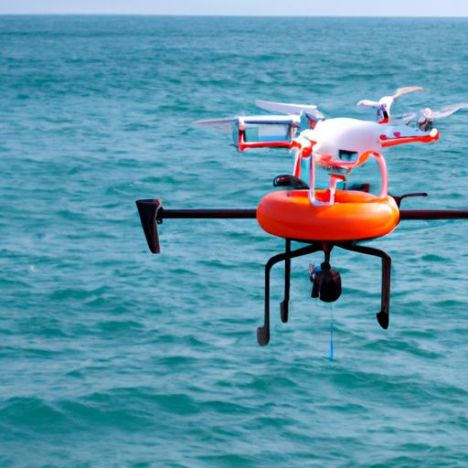Table of Contents
Benefits of Using Lifesaver UAVs for Water Rescue Operations
Water rescue operations are crucial in saving lives during emergencies such as drowning incidents or boat accidents. In recent years, the use of unmanned aerial vehicles (UAVs) has revolutionized the way water rescue missions are conducted. Lifesaver UAVs equipped with remote floating Life Buoys have proven to be invaluable tools in saving lives in water-related emergencies.
One of the key benefits of using lifesaver UAVs for water rescue operations is their ability to cover large areas quickly and efficiently. Traditional water rescue methods often involve manually searching large bodies of water, which can be time-consuming and labor-intensive. Lifesaver UAVs, on the other hand, can cover vast areas in a fraction of the time it would take a human rescuer. This speed and efficiency can mean the difference between life and death in a water rescue situation.
Another benefit of using lifesaver UAVs for water rescue operations is their ability to provide real-time aerial surveillance. Equipped with high-definition cameras, these drones can provide rescuers with a bird’s eye view of the situation, allowing them to quickly assess the scene and make informed decisions about the best course of action. This real-time aerial surveillance can help rescuers locate victims more quickly and accurately, increasing the chances of a successful rescue.
In addition to their speed and surveillance capabilities, lifesaver UAVs are also equipped with remote floating life buoys, which can be deployed to victims in distress. These buoys are designed to float on the water’s surface and provide a stable platform for victims to hold onto while awaiting rescue. By deploying these buoys remotely, rescuers can reach victims who are out of reach or in dangerous waters, increasing the chances of a successful rescue.

Furthermore, lifesaver UAVs are equipped with GPS technology, which allows rescuers to track the location of victims in real-time. This can be especially useful in situations where victims are drifting or moving in the water, making it difficult for rescuers to locate them. By using GPS technology, rescuers can pinpoint the exact location of victims and deploy the remote floating life buoys with precision, increasing the chances of a successful rescue.
Overall, the use of lifesaver UAVs for water rescue operations offers a number of benefits, including speed, efficiency, real-time aerial surveillance, remote floating life buoys, and GPS tracking. These drones have revolutionized the way water rescue missions are conducted, providing rescuers with the tools they need to save lives in emergency situations. As technology continues to advance, we can expect to see even more innovative solutions for water rescue operations, further improving the chances of a successful rescue.
How Remote Floating Life Buoy Controls Enhance Efficiency in Water Rescue Missions
Water rescue missions are critical operations that require quick and efficient response to save lives in distress. In recent years, advancements in technology have revolutionized the way these missions are carried out, with the introduction of unmanned aerial vehicles (UAVs) playing a significant role in enhancing efficiency and effectiveness. One such innovation is the remote floating life buoy control, a lifesaving equipment that has proven to be a game-changer in water rescue operations.
The remote floating life buoy control is a UAV equipped with a specially designed life buoy that can be remotely deployed to individuals in distress in the water. This innovative technology allows rescuers to reach victims quickly and provide them with the necessary support until help arrives. The buoy is equipped with a GPS tracking system, allowing rescuers to locate and retrieve the victim with precision.
One of the key advantages of the remote floating life buoy control is its ability to cover a large area in a short amount of time. Traditional water rescue methods often involve manually searching for victims, which can be time-consuming and inefficient. With the UAV, rescuers can quickly scan the water surface and deploy the life buoy to individuals in need, significantly reducing response time and increasing the chances of survival.
Furthermore, the remote floating life buoy control is equipped with a two-way communication system, allowing rescuers to communicate with the victim and provide reassurance and guidance until help arrives. This feature is particularly crucial in situations where the victim may be panicking or disoriented, as it helps to calm them Down and keep them safe until they can be rescued.
In addition to its efficiency in reaching victims quickly, the remote floating life buoy control also enhances the Safety of rescuers. By deploying the UAV to the scene, rescuers can assess the situation from a safe distance and determine the best course of action without putting themselves at risk. This not only protects the rescuers but also allows them to make informed decisions that can save valuable time in critical situations.
Another key benefit of the remote floating life buoy control is its versatility in different water rescue scenarios. Whether it’s a drowning victim in a pool, a swimmer caught in a rip current at the beach, or a boater in distress in open water, the UAV can be deployed to provide assistance quickly and effectively. This adaptability makes it a valuable tool for first responders and emergency services in a wide range of water rescue missions.
Overall, the remote floating life buoy control is a lifesaving equipment that has revolutionized the way water rescue missions are carried out. Its efficiency, safety features, and versatility make it an invaluable tool for rescuers in saving lives in distress. As technology continues to advance, we can expect to see further innovations in water rescue equipment that will further enhance the effectiveness of these critical operations.

